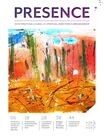Publications

Meyer, D. (2023). Examining the Landscape of Forgiveness. Presence Journal, Vol. 29(4), pp. 44-57. (Article)
|
This article examines the process of forgiveness from a spiritual perspective, what true forgiveness means, and the complexities that make this process so difficult. It is written for anyone struggling with the spiritual transformation that is required to truly forgive.
|
|
Meyer, D. (2021). Never Lost in Darkness: Doubt as the Beacon of Transcendence or The Divine Message of Inextinguishable Faith. Presence Journal, Vol.27(1), pp. 10-21.
(Article) |
This article examines the interdependence of fear, doubt, transcendence and faith as promises embedded within us and natural gifts from engaging in the creative process and engagement in inquiry. While offering some correlations to theological and philosophical sources to further reflect this interdependence, I offer the prospect that we can never lose our faith as it is held for us within our creative lives. For those moments when we are at a loss while attempting to help someone in a crisis of fear and uncertainty, redirecting them to their creative place can be the first step homeward.
|
|
Meyer, D. (2015). Connecting to the sacred through contemplative gaze. International Journal of Transpersonal Studies, Vol.43(1-2), pp. 83-86.
(Article) |
Visual contemplation can do more than convey images, it can transmit to the soul in ways that both inform and inspire. The artist shares the experience of empathic connection with another artist that may be cultivated by engaging with pieces that evoke emotional and somatic responses, and then entering into creative conversation with the artist by following their gestures, brush strokes, movement, marks, and color decisions. |
|
Meyer, D. (2015). The lost dialogue of artists: Negotiating the conjuring of art. International Journal of Transpersonal Studies, Vol.43(1-2), pp. 70-82.
(Article) |
This article examines the nature of the duologue between artist and creative source, as a lost interplay and negotiation within the gestation of the work in a uniquely individual language that can never be fully revealed, translated, or understood by a viewer. The author, an elder, late career studio artist draws comparisons to sacred language and interpretation positing that the conversations and relationships that form between artist and art are very different from those between works of art and humanity and have never been appropriately examined from an insider perspective. She offers reflections and writings of master artists as an attempt to illuminate the intimate exchange between artist, medium, and creative source.
|
|
Meyer, D. (2014). Reaching into shadow: An exploration of transcendence through artistic crisis (Doctoral dissertation). Available from ProQuest Dissertations & Theses database. (UMI No. 3607752).
|
This intuitively blended inquiry is a study of creativity as an agent of change. This is a study of the transpersonal potential within the dialogue between a late career artist and the work of art, as well as one’s life within art. The blend of methods used heuristic inquiry as the scaffolding for the entire study as this work is a creative work of art in itself. This inquiry took 2 questions into account: what is the nature of crisis within the artistic process and how does the shared space of artist and art that is penetrated by creativity as 3rd participant enlist crisis to move toward transformation?
|
|
Meyer, D. (2012). Interpreting Along the Deckled Edge, the Artist’s Place in Leadership. Integral Leadership Review, October 2012.
[Article] |
Defining the artist’s place in leading Corporate America enlists a creative process in itself, an orchestration of many different disciplines. In the harmony and blending of these voices, much like colors on a canvas, we find the heart and soul of integral leadership. Through deep understanding of Potentiating Arts™ (McCaslin & Snow, 2012), transformational learning (Mezirow, 2000), “congruous autonomy” (Scott, 2002), human motivation and creativity (Fox, 2005), and others, we offer wholeness to the organization and the individual in a comfortable space to conceive, explore, evolve, and celebrate (more). . .
|